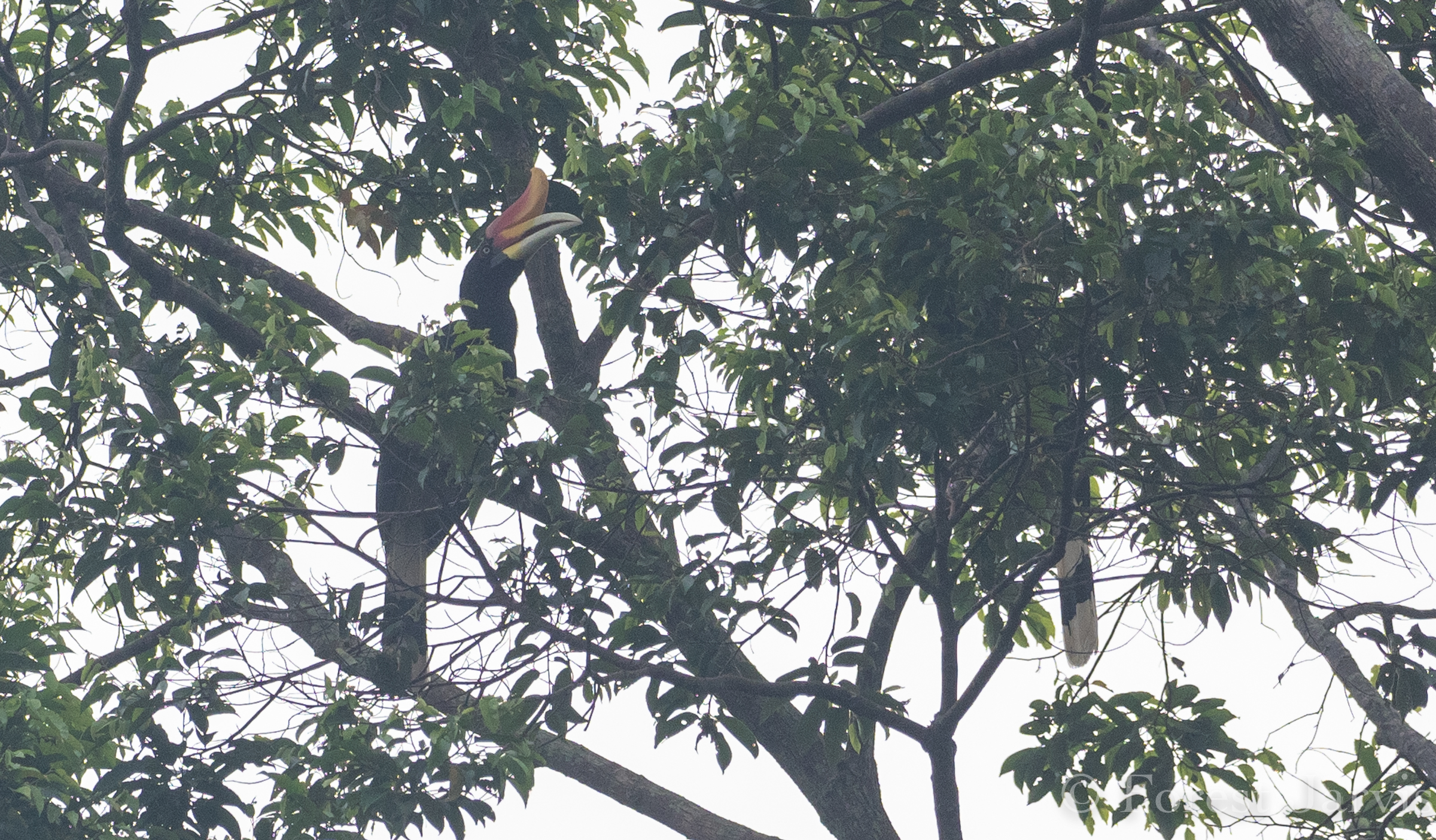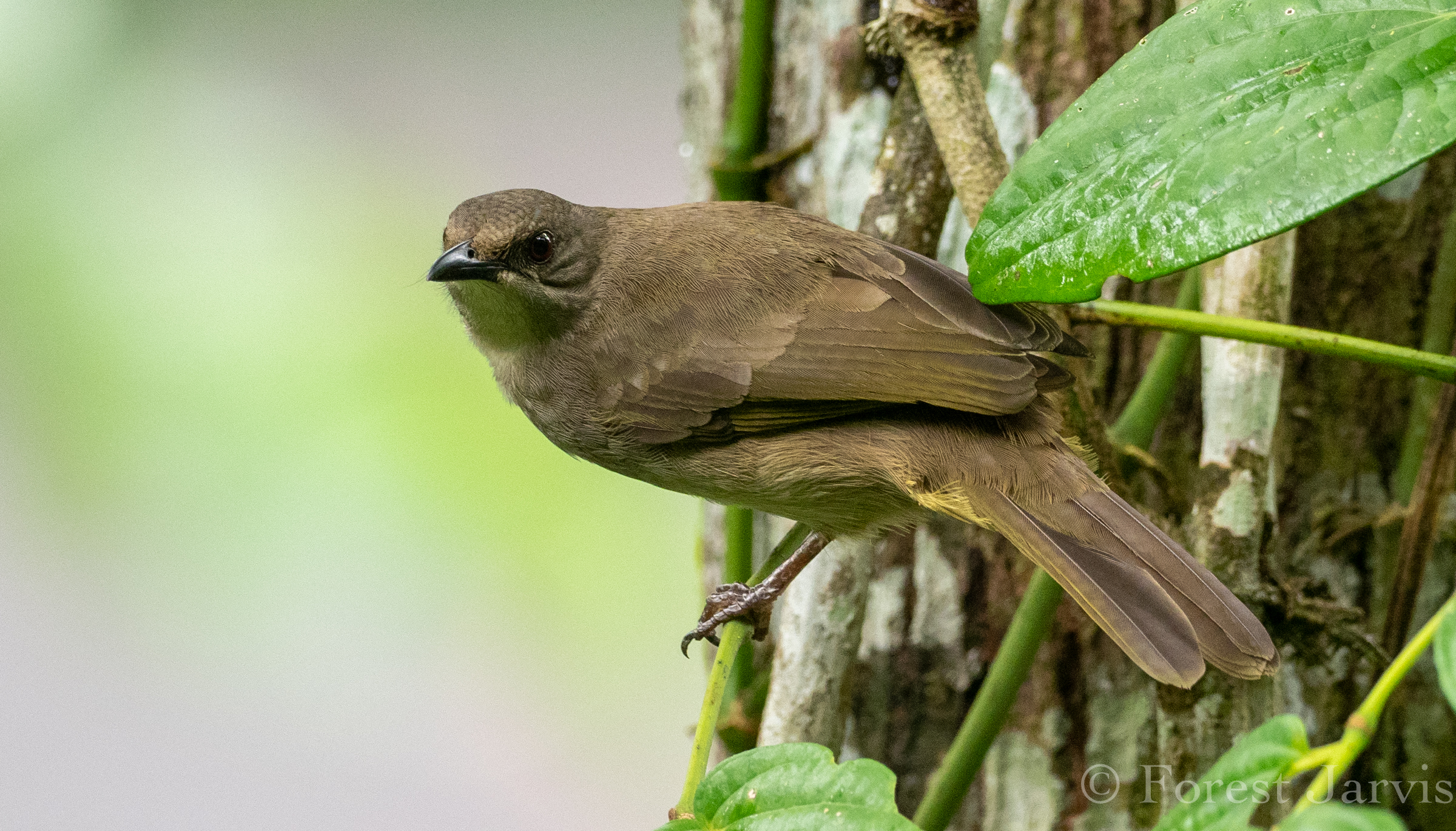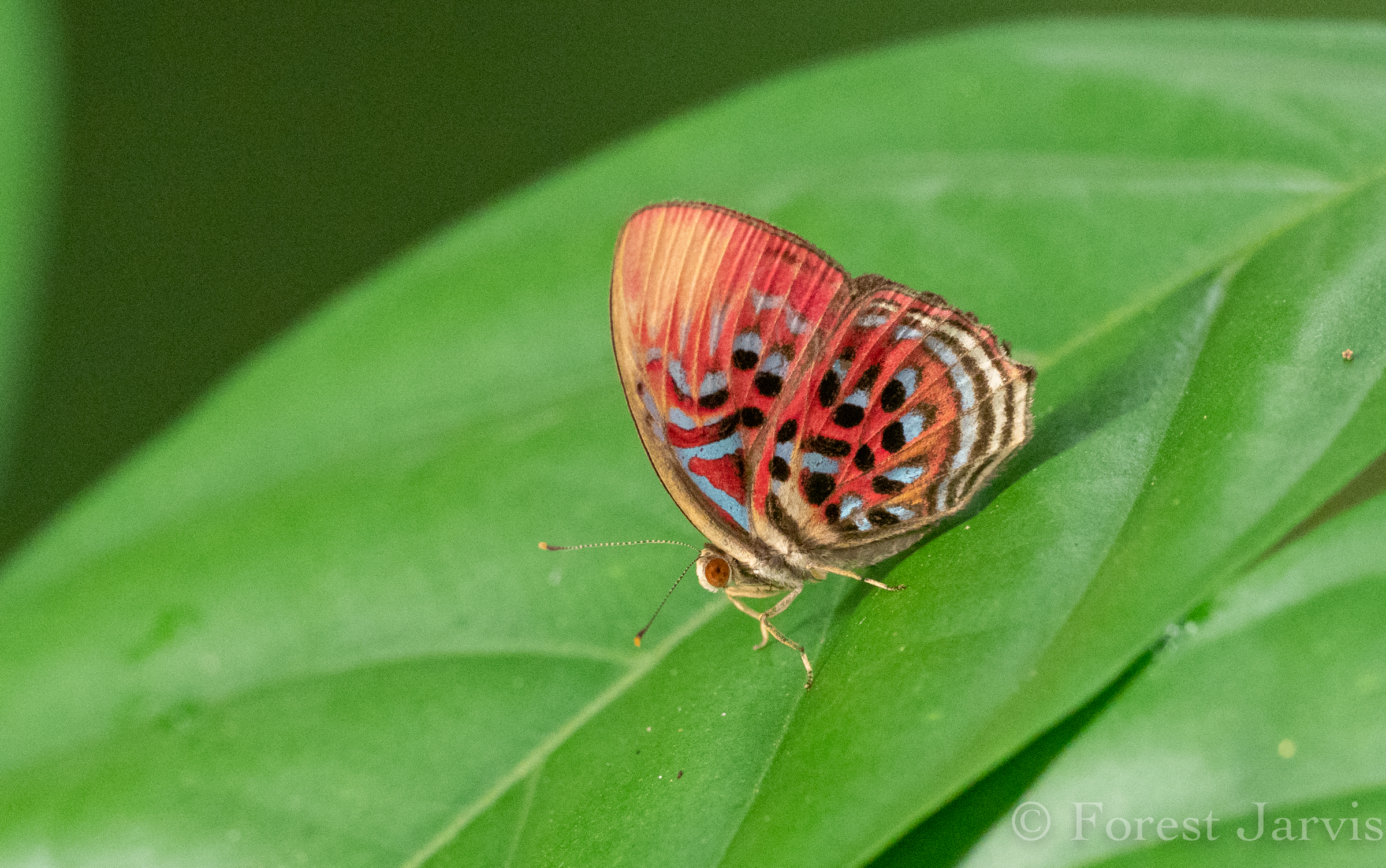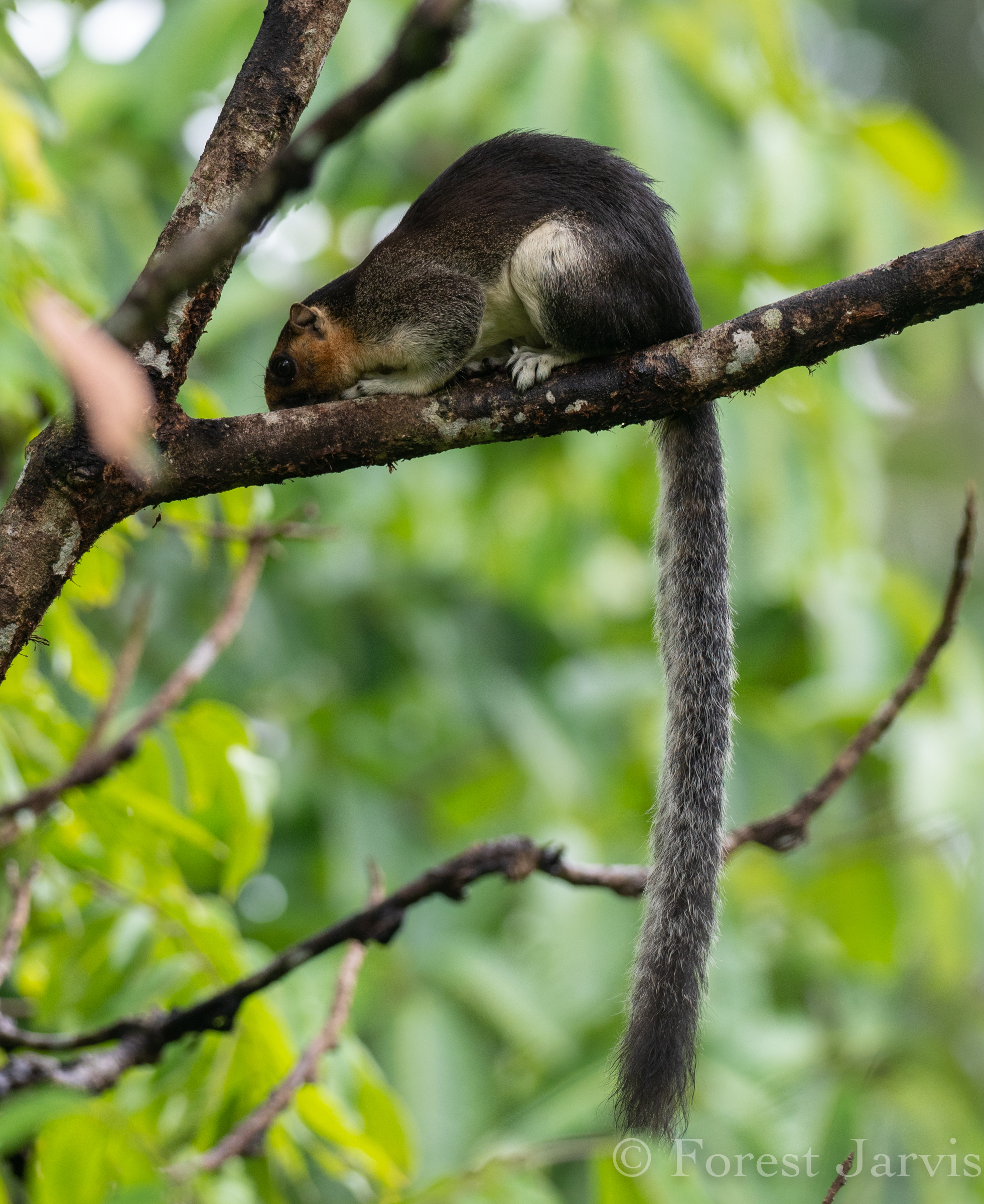On New Year's Day of 2020 left Kota Kinabalu and headed toward the town of Sandakan on the other side of the island, where we would spend the next couple of nights. In what I guess was just ominous foreshadowing of the rest of 2020, things didn't go entirely as planned from the start. We arrived at the airport to pick up a rental car, only to find that they'd set aside the wrong car for us (I'm not good at driving stick shift, to my eternal shame). Once that was sorted out and they'd found a proper car, we set out. The plan was to take a detour through the Crocker Range, the spine of mountains running down Borneo's west coast that's the home of several birds that are difficult to see anywhere else, including Bornean Barbet and Bornean Bulbul.
What we weren't aware of when we were making plans was that construction along the main route to eastern Sabah meant that the road through the Crocker Range went from being a peaceful two-lane scenic mountain detour to a massive thoroughfare for all cross-island traffic, albeit still with two lanes. It was a miserable couple of hours to get to the mountain birding area, stuck behind slow-moving trucks and dodging reckless drivers traveling in the opposite direction. When we finally got to the birding area, outside the now-shuttered Rafflesia Information Centre, it was a foggy, rainy late morning, with dozens of vehicles roaring by at unsafe speeds. Not ideal for birding!
Nonetheless, we'd come that far, so I decided to walk around briefly to see if there was anything interesting around (Nikki stayed in the car). I did hear calling Mountain Barbet and Golden-whiskered Barbet, but unfortunately no Bornean Barbet. A Crimson-headed Partridge called briefly, and I heard another unseen partridge call from just beside the road that I couldn't identify (was it the nearly-unknown Hose's Partridge found in the area? The world will never know). I was about to head to the car when I noticed a small flock of birds feeding in some saplings next to the road. There was a Cinereous Bulbul and, even better, a Bornean Bulbul! The Bornean Bulbul is one of the most sought-after endemic bulbuls, and a Crocker Range specialty, so it was great to get an unusually good look at one. The same bushy area held a young Rufous-tailed Jungle Flycatcher, a bird I'd previously seen in Mindanao, but that's much less-often seen in Borneo.
 |
| Bornean Bulbul! |
 |
| Rufous-tailed Jungle Flycatcher |
I returned to the car and we went a little down the road to where we could turn off and do some more walking. Unfortunately I didn't see any more interesting birds, but there were some cool insects to keep me busy for a while before doing the rest of the drive.
 |
| Some kind of strange spittlebug |
 |
| Nisitrus musicus |
 |
| A very strange-looking cobweb spider (Phoronicidia sp.) |
 |
| Boczkittetix borneensis, an odd-looking pygmy grasshopper |
After our stop in the Crocker Range, it was an excruciating 6-hour drive across Borneo to get to Sandakan, our destination. The roads were packed with vehicles, probably resuming shipping after a holiday break, and it felt like most of the route just consisted of either passing slow-moving trucks or wondering when the next time it would be safe to pass the slow-moving truck in front of me would be. It didn't help that the road to Sandakan is in terrible shape, full of potholes and treacherous patches of loose gravel. It reminded me of driving in Michigan, to be honest.
We arrived in our hotel just before sunset, and stopped just long enough to drop off our things in our room before heading to the Sepilok Rainforest Discovery Centre next door. We'd visited the RDC on our previous trip to Borneo in 2017, and one of our favorite parts had been a night hike, where we saw some amazing mammals like Bornean Orangutan and Horsfield's Tarsier. We were excited to try it again this time.
Unfortunately, our second go at our night hike wasn't quite as productive as the first one, although we still saw some interesting wildlife. The RDC has an impressive canopy walkway through some remnant old-growth forest, and the walkway just after sunset hosted a nesting Wallace's Hawk-eagle and a distant Red Giant Flying Squirrel. A walk through the forest pathways in the dark gave us some very cool insects and other invertebrates, as well as a roosting Oriental Dwarf Kingfisher. The highlight of the night would have been a Slow Loris that our guides discovered, but it was so high up in the tree that no-one could get a good look or a picture- all I saw was a 2-second view of a Slow Loris butt as it disappeared behind a tree branch, never to be seen again.
 |
| Flat-tailed House Gecko, an incredibly noisy gecko seen by the RDC headquarters. |
 |
| Wallace's Hawk-eagle |
 |
| Red Giant Flying Squirrel |
 |
| Giant Forest Ant (Dinomyrmex gigas), the biggest ants I've ever seen |
 |
A scary-looking whip scorpion of some sort
|
 |
| Oriental Dwarf Kingfisher |
 |
| Pyrops whiteheadi, an absurd-looking lanternfly |
 |
| A giant centipede (Scolopendra sp.) over a foot long! |
The next morning, Nikki wasn't feeling well so she slept in while I headed out at sunrise to bird the RDC. I started on the canopy walkway as the sun was rising, and was greeted with a surprisingly quiet morning. There were a few birds singing, most of them rather familiar to me, although I did see my lifers Spectacled Bulbul and Plain Flowerpecker. An endemic Yellow-rumped Flowerpecker posed nicely, and I got great looks at a beautiful pair of Rubycheeks, strange primitive sunbirds.
 |
| Plain Flowerpecker |
 |
| Yellow-rumped Flowerpecker |
 |
| Female Rubycheek |
 |
Male Rubycheek
|
After a slow start, things picked up a little bit. I saw my lifer
Long-billed Spiderhunter feeding on some canopy flowers, and another lifer in the form of a
Lesser Cuckooshrike. The
Wallace's Hawk-eagle was back building its nest, while a
Violet Cuckoo was doing its display flight. I got great looks at a
Black-winged Flycatcher-shrike and a pair of
Black-naped Monarchs, common throughout the Sunda forests. Two more lifers were a beautiful
Grey-bellied Bulbul and an uncommon
Yellow-breasted Flowerpecker (distinct from the Yellow-rumped Flowerpecker I'd already photographed, and the Yellow-vented Flowerpecker I also saw that morning. Suffice it to say ornithologists aren't always that creative with bird names).
 |
| Long-billed Spiderhunter |
 |
| Lesser Cuckooshrike |
 |
| Wallace's Hawk-eagle working on its nest |
 |
| Male Black-winged Flycatcher-shrike |
 |
| Female Black-winged Flycatcher-shrike |
 |
| Female Black-naped Monarch |
 |
| Tailless Disk Oakblue (Arhopala epimuta) |
 |
| Grey-bellied Bulbul |
 |
Yellow-breasted FlowerpeckerAdd caption
|
After an hour or so on the canopy walkway, I decided to explore some of the RDC's forest floor pathways. Near the RDC cafe I happened across a
Thick-billed Spiderhunter feeding on nectar, and nearby it a
Grey-headed Canary-flycatcher. Bird photography was difficult on the forest floor, with most birds heard rather than seen, but I did see my lifer
Greater Green Leafbird (almost identical to Lesser Green Leafbird), and a distant flock of
Bushy-crested Hornbills.  |
| Thick-billed Spiderhunter |
 |
| Grey-headed Canary-flycatcher |
 |
Malayan Assyrian
|
 |
| Rough Mabuya |
 |
| Common Parasol (Neurothemis fluctuans) |
 |
| A very distant Bushy-crested Hornbill |
 |
A smart little jumping spider (Thorelliola ensifera)
|
I began heading back towards our hotel so that I could meet Nikki for breakfast. In the RDC parking lot a Black Hornbill was perched in a low tree, while I got my first (and only) look at a Dusky Munia, supposedly one of the commonest Bornean endemics. One of the highlights of the morning was a beautiful Copper-throated Sunbird perched in a bush that sat quietly and let me take as many pictures as I wanted.
 |
| Black Hornbill |
 |
| Copper-throated Sunbird |
 |
| A beautiful Clipper (Parthenos sylvia) at our hotel garden |
Nikki was feeling better that afternoon, so she joined me for another walk through the RDC. We started on the forest floor paths, which were mostly quiet in the afternoon heat. In a forest clearing we happened across a pair of Lesser Green Leafbirds, a bright blue Verditer Flycatcher, and an impressive Chestnut-breasted Malkoha, a bird we'd seen before in Palawan.
 |
| Chestnut-breasted Malkoha |
It was as we were walking away from the clearing that we had one of the most magical moments of our trip. A movement on the ground alerted us to a small bird moving toward us. It was a
Short-tailed Babbler, one of the cuter babblers of Southeast Asia, and it was hopping along the ground, singing to us as it came within arm's reach of us! We spent the next five minutes being chased down a jungle path by a babbler, which hopped up to our feet each time we tried to back up to take a picture, stopping occasionally to munch on worms from the forest floor. I ended up having to use my macro lens to get pictures of it, since it was too close for my telephoto to be of any use. It was one of the most intimate wildlife experiences I've ever had (reminiscent of my
White-faced Owl encounter in Ethiopia last year), and it felt like we were Disney princesses or something.
 |
| Our Short-tailed Babbler friend |
 |
| Nikki with our babbler friend |
As the afternoon turned into evening and the light grew dimmer, we headed up to the canopy walkway, where there were a few new birds, including a distant pair of Buff-fronted Woodpeckers. A very strange-looking bird perched above us gave us no end of confusion until we realized it was a Wallace's Hawk-eagle holding two palm fronds in its beak. The best bird on the walkway was a small flock of Black-and-yellow Broadbills, strange-looking denizens of the Southeast Asian forests. I've got terrible luck with broadbills outside of the Philippines (where I have very good broadbill luck), so it was nice to finally connect with these ones.
 |
| Buff-fronted Woodpeckers |
 |
| Wallace's Hawk-eagle disguised as an alien |
 |
| Black-and-yellow Broadbill |
That evening at our hotel, I saw some cool night creatures, and heard both a Large-tailed Nightjar and Brown Hawk-owl calling, though I wasn't able to see either of them.
 |
| A brilliant moth (Eudocia dividens) at our hotel |
 |
| Twin-spotted Gecko |
I headed out alone again the next morning, as Nikki was still feeling under the weather. As soon as I entered the RDC, I heard the bugling calls of a flock of Rhinoceros Hornbills, one of the largest and most impressive hornbills. It took a while before I got a glimpse of them in a distant tree, but it was one of the highest birds on my target list, so I was happy to see them even from afar.
 |
| Rhinoceros Hornbill |
On the canopy walkway, it was even quieter than it had been the previous morning- a little surprising. I came across a flock of brilliant Scarlet Minivets, much redder than the ones in the Philippines, and a couple of endemic Brown Barbets feeding on a fruiting vine. I got another look at a Black-and-yellow Broadbill, as well as more common birds like Ruby-cheeked Sunbird and Olive-winged Bulbul.
 |
| Male Scarlet Minivet |
 |
| Immature Scarlet Minivet |
 |
| Brown Barbet |
 |
| Black-and-yellow Broadbill |
 |
| Male Ruby-cheeked Sunbird |
 |
| Female Ruby-cheeked Sunbird |
 |
| Olive-winged Bulbul |
I took a brief walk along the forest paths, where I saw some brilliant butterflies and not much else, then went back to get Nikki so we could do some final birding before leaving Sepilok. We did some walking along the canopy walkway, where we saw a distant flock of shiny-green Blue-crowned Hanging Parrots and a Cream-eyed Bulbul (recently recognized as a new species), but not much else new. We got good looks at a couple of huge Pale Giant Squirrels as well, and down below a brightly-colored assassin bug. All too soon it was time to leave and head to Mount Kinabalu, our final destination. Outside our hotel as we were leaving was a troupe of Southern Pig-tailed Macaques, mostly females and some cute babies.
 |
| Common Red Harlequin, a gorgeous metalmark butterfly |
 |
| Amata macroflavifer, a day-flying wasp moth |
 |
| Giant Saturn, one of the biggest butterflies I've ever seen |
 |
| Asian Hermit Spider (Nephilengys malabarensis) |
 |
| Pale Giant Squirrel |
 |
| Cream-eyed Bulbul, which looks exactly like about 10 other species of bulbul but is different, apparently |
 |
| Blue-crowned Hanging Parrot |
 |
An impressive-looking assassin bug (Eulyes sp.)
|
 |
| Female Southern Pig-tailed Macaque |
 |
| Baby Pig-tailed Macaque |
On our way back westwards, we stopped by a nearby Proboscis Monkey sanctuary, since I've never seen those very strange monkeys. Upon arrival, however, we found out that it was over $50 per person to enter, which I didn't even have the cash to pay for. The detour wasn't for nothing, however- we happened across some more Pig-tailed Macaques, including some terrifying-looking alpha males, and a few nesting Baya Weavers, one of the few weavers found outside of Africa. Baya Weavers look exactly like lots of other weavers I got used to seeing in Ethiopia, but it was a new bird for Nikki, and it was pretty cool to watch them building their hanging nests.
 |
| Southern Pig-tailed Macaque- basically just an Asian baboon |
 |
| Baya Weaver |
After our weaver spectating, it was a 4-hour drive to Mount Kinabalu, where we would spend the next couple of days- but that's for the next blog entry.




































































































Comments
Post a Comment